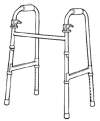Advance Care Program: Mobility
WALKERS
 PURPOSE: Walking aids are designed to give the user added stability and when used properly, increased independence. Your physician has ordered your walking aid for a specific reason. If your physician has given you specific instructions, you must follow them specifically. If you have not seen a therapist or physician, please do so.
PURPOSE: Walking aids are designed to give the user added stability and when used properly, increased independence. Your physician has ordered your walking aid for a specific reason. If your physician has given you specific instructions, you must follow them specifically. If you have not seen a therapist or physician, please do so.
TYPES: Walkers come in a variety of styles and sizes, each with a specific purpose. Walkers can come with seats, brakes, baskets, and/or wheels. Make sure you read and understand all manufacturers' operating instructions. Folding walkers are just as strong as non-folding walkers and have the added convenience of compact storage. Most walkers have a 250-300 pound weight limit. Check with your medical equipment supplier for the specific weight requirements for your walker; heavier duty models are available by special order.
FITTING: A properly fitted walker is adjusted for height when wearing the shoes you will be wearing while walking with the walker. The top of the handgrips should be approximately at the hip joint and the elbows will be slightly bent (20 - 30 degree angle). Make sure all walker legs are adjusted to the same height.
WHEELS & BRAKES: Walkers have many styles of wheels. Walkers with two wheels are very common and wheels must be in the front position. Walkers with four wheels must have a braking mechanism due to the possibility of losing balance. Braking mechanisms vary in their performance and braking ability, the user must comply fully with manufacturers' operating procedures. Most medical equipment suppliers maintain many different types of walkers with brakes and brake add-ons.
USE: Your wrists must be straight and firmly grasping the handgrips. Your first step should be even with the back two legs of the walker, followed by a second step into the middle of the walker. The walker is then moved forward, stepping through the walker last (exactly the same as a normal walk). The feet do not meet side by side unless stopping for a reason. If your walker has a seat, the brake must be fully engaged when utilizing the seat. If your walker is of the folding type, make sure the spring buttons are fully engaged.
SAFETY: Use extra caution for mobility risks and risks of falling, including:
- Poor lighting: Use of nightlights, flashlight by bedside, lamps or light switch that can be reached easily.
- Poor walk spaces: Fix loose floorboards, paint uneven floors, use wet floors signs, keep snow and ice cleared from entrances, ensure carpet is firmly attached to the stairs, do not walking in stocking feet, and remove loose rugs, clutter, cords, and excess oxygen tubing.
- Equipment: Replace worn or cracked walker, crutch, and cane tips, use colored oxygen tubing on light carpet, and tighten loose handrails.
- Bathroom: Install grab bars, use bath mats with suction cups, and use elevated toilet seat.
- Medications: Be aware of medications that may cause dizziness, drowsiness, and unsteadiness.
MAINTENANCE: The rubber tips and wheels on your walker are very important and you should inspect them regularly. Worn or damaged tips and wheels must be replaced immediately. Medical supply companies maintain a wide variety of walker tips and wheels that are inexpensive. The handgrips should be checked for movement or slippage, if applicable, on a regular basis and replaced if damaged. Braking mechanisms should be checked for braking ability at least monthly. If your walker does not brake completely, please bring it to the store where you purchased it so adjustments can be made.
More Mobility Topics
Canes & Quad Canes
Crutches
Walkers
Bath Benches & Safety Rails
Commodes
Grab Bars



